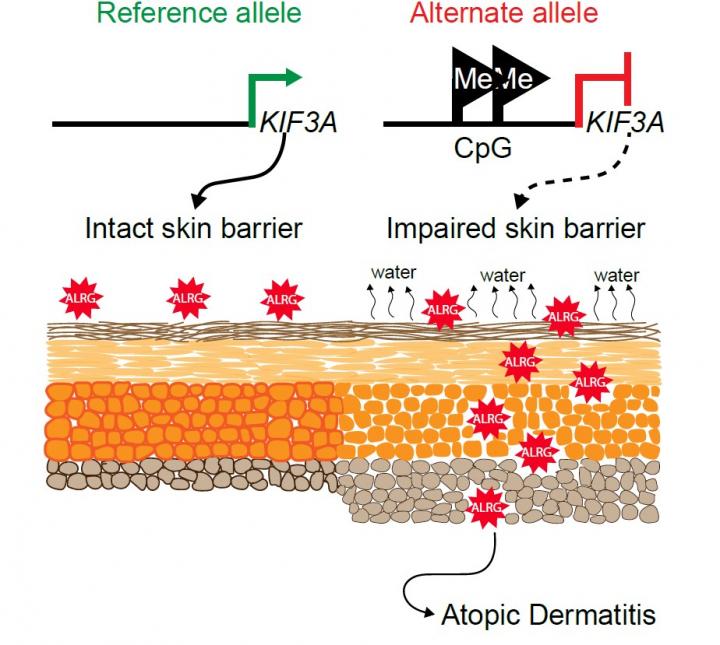Discovery could lead to new screening tests and potential treatments

Credit: Cincinnati Children’s
Two common variants in the KIF3A gene increase the risk of young children having a dysfunctional skin barrier and developing the skin condition atopic dermatitis. This, in turn, can allow environmental exposures to more easily cross the skin barrier and contribute to the development of food allergies and asthma as they grow up.
These findings, led by scientists at Cincinnati Children’s, were published online Aug. 14, 2020, in Nature Communications. The first author was Mariana Stevens, PhD, and the senior corresponding author was Gurjit Khurana Hershey, MD, PhD, Director, Division of Asthma Research.
The study sheds new light on the genetic and molecular mechanisms at work in atopic dermatitis, a common condition (also known as eczema) that affects as many as 20 percent of all children. Although eczema usually resolves as children age, many children with disrupted skin barriers go on to develop more severe conditions including asthma and food allergies.
The study findings could make it easier to identify which children with eczema are most likely to progress to other allergic conditions. This would allow lifestyle interventions and other preventive therapies to be targeted toward high-risk children. The study also suggests a new target for potential treatment.
“Food allergies are rising and the causes are not entirely clear,” Hershey says. “This study adds evidence to a rising theory that skin health is more closely connected to lung and gut health than many have suspected.”
Two tiny SNPs play big roles in skin health
A single nucleotide polymorphism (SNP) is a common genetic variation in a DNA sequence. In this study, researchers found two SNPs in the KIF3A gene that were confirmed through a series of experiments in children, as well as preclinical studies in mice, to play direct roles in developing eczema.
These SNPs (rs11740584 and rs2299007) are linked to increased water loss through the skin, dry skin and the characteristic damage seen in atopic dermatitis. Measuring the rate of this type of water loss is one method for determining how severe a child’s eczema may be.
Proper function of the KIF3A gene is important because it helps cells form their primary cilia, a structure on cell surfaces that acts as an antenna to receive important signal information from other cells. Previous studies led by experts at Cincinnati Children’s and others have already shown that malfunctioning KIF3A in lung tissue can lead to asthma. Likewise, malfunctions of the same gene in gut tissues can increase risk of food allergies.
Now, this study helps connect both of these allergy risks to a damaged skin barrier, which allows more allergy-triggering substances to get inside our bodies to prompt immune system over-reactions.
“We are working to better understand how skin, gut and lung health are connected. In fact, we have a grant from the National Institutes of Health to further study this connection,” Hershey says.
Development underway for screening test
The research team at Cincinnati Children’s has begun searching for drug compounds that might someday be useful in restoring the disrupted functions of the KIF3A gene. But the first next step based on this study will be to continue an ongoing hunt for a rapid screening test.
The new study in Nature Communications builds on findings from two other studies published earlier this year from Cincinnati Children’s scientists.
- In February, a study in the Journal of Allergy and Clinical Immunology reported that the allergy risk posed by atopic dermatitis was higher than having a parent with allergic disease.
- Then in April, a study in the same journal demonstrated the value of using pain-free tape stripping as a less-invasive tool than skin biopsies for gathering data about skin health.
The goal, Hershey says, would be to use skin tape strip samples to quantify KIF3A expression as a possible tool for predicting disease risk. The team is studying this approach in a group of 600 children from the Cincinnati region who were identified with atopic dermatitis early in life. This group, the first cohort of its kind in the US, will be followed for five years to directly evaluate the ability of KIF3A genetic variations and skin expression to predict disease risk.
###
About this study
This study included Cincinnati Children’s co-authors from the divisions of Asthma Research, Biomedical Informatics, Developmental Biology, Human Genetics, Pathology and Laboratory Medicine, and the Center for Autoimmune Genomics and Etiology. The work also included collaborators from the Shriners Hospitals for Children and the Department of Surgery at the University of Cincinnati College of Medicine.
Funding sources include an NIH grant shared by three co-authors (U19AI70235); six agencies of the National Institutes of Health that support the Genotype-Tissue Expression (GTEx) Project; and a grant from the National Center for Research Resources and the National Center for Advancing Translational Sciences (UL1 TR001425).
Media Contact
Tim Bonfield
[email protected]
Related Journal Article
http://dx.





